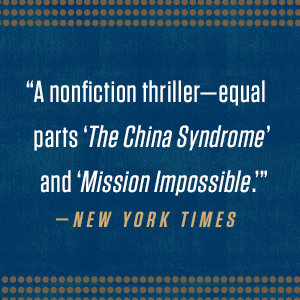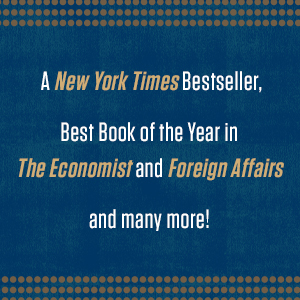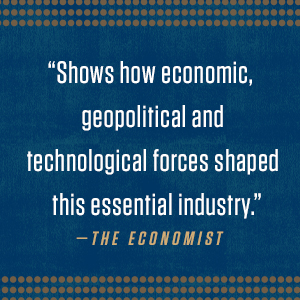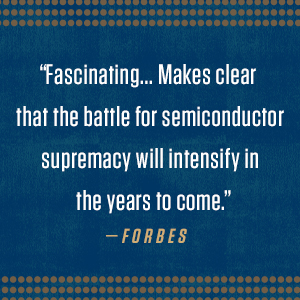Customer Services
Copyright © 2025 Desertcart Holdings Limited
Desert Online General Trading LLC
Dubai, United Arab Emirates



Full description not available








A**N
Extremely well timed overview of the history of semiconductor manufacturing
Chip War is a well timed history of semiconductor manufacturing and the intellectual currents that drove offshoring as well as bring concern over national security. The book is both historically informative as well as currently illuminating for thinking about the current US - China frictions on semiconductor manufacturing. One can learn about the pioneers of the industry and the history of government involvement as well as the cycles of intellectual property concerns. Chip War is both highly relevant for better understanding today's world of widening geopolitical fault lines as well as contextualizing how similar and or different things are today vs the past.The book starts out something along the lines of Walter Isaacson's Innovators giving the history of silicon valley and the discovery of transistor by Bardeen and Brattain, and then Shockley. The key characters who built up Silicon Valley and the entrepreneurial spirit that they embodied is highlighted so that one gets a sense of the early days in the valley. The competitiveness but also fluidity of the system led to significant innovation in the early days and the author gives a picture of the ecosystem. The first construction of the integrated circuit is discussed and the early development of logic chips is highlighted. The author is quick to highlight that copying technology is no route to success as its not technical knowledge but process expertise which is critical, understanding how to scale the business and increase yields is the key to consumer businesses which are critical for true scale. The Soviet Union attempted to catch up on semi-conductors via espionage which was a strategy destined for failure and the author gives the strong reminder that innovation is what drives the business not replication. At the early stages of the tech revolution the US dominated but was insulated from competition.The author moves on to the world as the conditions changed and Japan caught up. At first it was licensing technology on lower end goods but with Sony and others the tech gap narrowed and it looked like Japan was on the track to outpace the US. The US appeared to be lagging a more disciplined competitor with subsidized capital that was more cost competitive. Thus the reader gets a reminder that tech competition is not new and there is a strong reminiscence today of the competition with Japan in the 80s. Ultimately the concerns about Japan were overblown and eventually the US regained its intellectual lead where its competitive edge was strongest but with the exception of Micron, tech hardware manufacturing was slowly moving offshore. The author then moved on to the origins of TSMC and a little bit on Samsung. In particular for TSMC one learns that Morris Chang, founder of TSMC was a TI executive and not actually Taiwanese. Nonetheless the story of the rise of Taiwan in the tech supply chain is discussed and the relevance of the ambiguity with regards to China completely overlooked. The era of offshoring was the era of globalization where cost efficiencies were what determined capex decisions and the US government was not in the business of subsidizing capital despite the rest of Asia fully embracing that.The author moves on to China and the growth of a new kind of competitor. This competition was not as concerning until the last decade. Huawei is discussed as is the IP theft from Micron and the challenges of moving up the curve is highlighted with the lack of progress by SMIC. Chip Wars does a good job of bringing in the need of cutting edge processes for military dominance and the greater frictions that are arising due to these security concerns with China that were absent with prior competitions. The disregard of intellectual property is also highlighted through the Micron fiasco where Chinese courts used their system to blackmail Micron, though this backfired. Finally the author moves on to EUV and the astronomical complexity of the manufacturing process. The true complexity is used to show the fundamental challenge of trying to fast track your way to the cutting edge of tech hardware manufacturing. It is also used to highlight the truly global collaborative environment that was embraced to develop the technology and that same environment also led to offshore from the US without a concern.We are now in a new era where supply chain stability is being reconsidered as more important than supply chain cost. For technology this has big repercussions. On the margin we can certainly see the reverberations with the chip equipment export constraints and it is likely that these are used on a continued basis to manage competition in a fundamentally different way than in the past. To understand the history so that one can better appreciate the context, Chip War is a must read.
C**K
Haven’t read a more important book in a long time
I can still remember being very young and listening with my father to his vacuum tube radio. My memory of those glowing tubes is somewhat faint though because that tube radio soon got replaced by something a lot smaller. The age of the transistor radio had arrived.At that point in time, sometime in the 60s, no one could have imagined how the world was going to be impacted by transistors and integrated circuits etched on silicon wafers. In this book, Chris Miller traces the evolution of the semiconductor chip. It’s a journey that tracks technological innovation from the very beginning when physicists worked out how to create transistors on silicon to the age of modern day chips with billions of transistors crammed into tiny chips by manufacturing processes that are insanely complex. Parallel with the mind boggling tech innovation, Miller also records the vitally important history of the geopolitical ramifications of the semiconductor industry. We learn how important chips are in modern warfare.Taiwan’s critical role within the semiconductor global supply chain and the very small number of other important players are crucial factors as we think about how tech and geopolitical rivalries evolve.While the U.S. had the early lead and still leads by many measures, China is quickly catching up. We are told that China is not making the same mistakes that the Soviet Union made when they sought to keep pace with the U.S. in chip technology. Semiconductors are deeply enmeshed in the U.S.-China power struggle. Reading this book, one gets the impression that China’s efforts to create an advanced domestic chip industry may yet surprise the world. One is left wondering if China will perhaps deliver a “DeepSeek Moment” in the realm of semiconductor technology.For anyone curious about the future and interested in technological innovation and geopolitics, this book tells a truly important story in an interesting and even exciting way. From start to finish it is packed with information that you will want to know about.
F**8
Good reference book
Well researched book that follows the Chips industry from its early infancy until 2022. As the sector is still evolving rapidly, this book is already a bit outdated and better used for historical references.Despite his best efforts to stay objective, the author invariably portrays the US as always "reasonable" while other countries are either "cheating" or "dangerous". For example, while many US chip companies are "heroically" helping US military to create deadly weapons, any Chinese tech company with any military association should be blacklisted.The author also annoyingly mentions "Gordon Moore" and "Caltech professor Carver Mead" together, many times, ignoring the fact that Moore himself is a Caltech PhD.
E**B
Definite buy, read, read again, and take notes
This book transformed my understanding of the chip industry, which is the heart of the US economy. Possibly the best book I’ve read in years.
Trustpilot
2 months ago
3 days ago